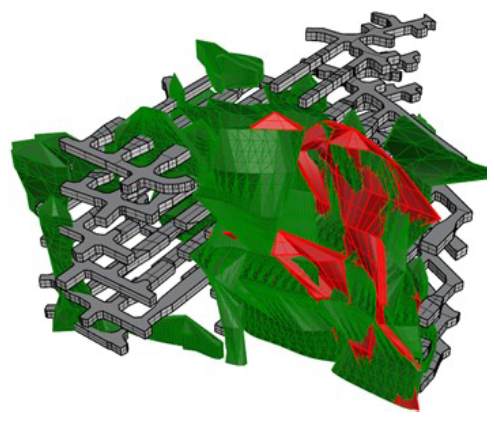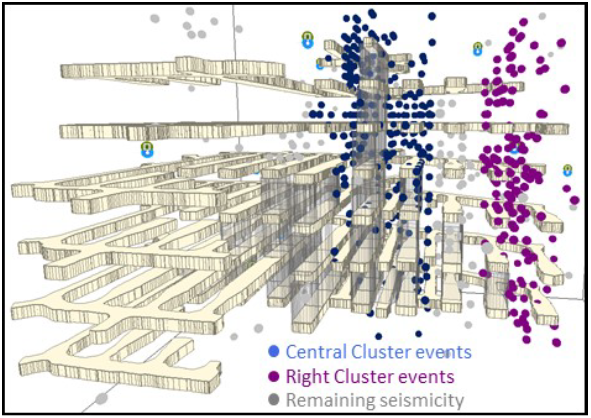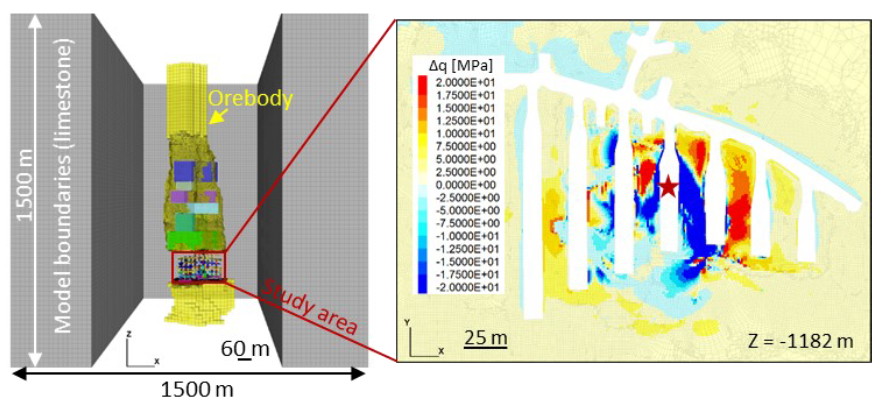
Inclusive strategies to better understand and control seismo-geotechnical hazards in deep underground operations.
Ineris develops inclusive strategies to study and assess both aseismic and seismic rock mass response to massive extraction. This study demonstrates how combining high resolution microseismic monitoring with 3D mine-wide geomechanical modelling and in situ stress measurements enables to better quantify mine-induced stress changes and subsequently induced seismicity patterns. Enhancing mine sequence design in a complex geological setting appears as a key objective to better prevent geological hazards.
CONTEXT. Mining of deep massive orebodies induces considerable stress field changes causing large aseismic deformations and creep effects, high stress concentrations zones, fracturing and also mining-induced seismicity. The latter can result in rock falls or rock ejection phenomena, which represent a serious threat for miners safety and mine infrastructures integrity. In a deep hard-rock mine, located in Sweden, ore is extracted using sublevel stoping method down to about 1300 m depth. The orebody, characterized by sulfides deposits, is hosted in a limestone-dolomite unit and interbedded with weak talc-schist lenses. Because of the contrasted geological setting, increasing mining depths and very high extraction rates, seismo-geotechnical instabilities are an increasing threat.
Solution. A deep mine district has been equipped with a local monitoring network consisting of stress cells and seismic sensors. The microseismic array was accurately designed, by means of numerical simulations, to optimize its performances in term of lower detectable magnitudes and location accuracy. In this manner, induced seismicity can be reliably quantified in the whole volume of interest while the overall rock mass response is locally assessed by means of continuous stress measurements performed in the heart of the production area. In parallel to near real-time monitoring, stress changes and failure zones are computed at larger scales by means of 3D district-wide geomechanical numerical model.

3D schematic view of the embedded weak (green) and very weak (red) interlaced hosting rock mass part of the geological setting delineating the orebody.
Results. Accurate microseismic localization enables identifying seismic active clusters which represents overstressed areas surrounding the mining works. Space-time analysis and source characterization of these clusters highlight two types of seismic rock mass responses: one local and temporally short directly induced by production blasts and fresh excavations (central cluster), the other long-lasting over time and remote from excavations being mainly controlled by geological heterogeneities (right cluster). Both types of seismicity appear to be strongly related with the local geology and mine sequencing but poorly to the volume of extracted of ore.

Time-space characteristics of microseismic clusters versus mining progress yield a clear picture of freshly excavated mine induced events (here central cluster), geologically induced events (right clus-ter) and diffuse events (remaining seismicity).
In parallel with this, geotechnical data and visual observations in the mine show the occurrence of aseismic deformations, as well as evidence of extensive creep phenomena induced by mining.
3D geomechanical modelling of the step-by-step mining sequence shows large plastic deformations within interbedded weak geological zones, unable to bear high stresses and therefore impose a mechanism of stress transfer beyond immediate surroundings of excavated areas. Overall inclusive interpretation shows clearly that the presence of these talc-schist lenses results in a global stress shift and microseismic failures to a distance of about a factor 7.
3D geomechanical modelling of the step-by-step mining sequence shows large plastic deformations within interbedded weak geological zones, unable to bear high stresses and therefore impose a mechanism of stress transfer beyond immediate surroundings of excavated areas. Overall inclusive interpretation shows clearly that the presence of these talc-schist lenses results in a global stress shift and microseismic failures to a distance of about a factor 7.

Upper panel: Cumulated microseismic activity and mining blasts (stars). Lower panel: strain time series recorded on one of the stress cells and mining blasts (dashed lines) showing immediate stress changes followed by aseismic deformations of the host rock.
Lesson learned. In such an environment, characterized by large production rates at significant depths within a complex geological setting, microseismic monitoring coupled with strain -stress measurements and 3D geomechanical modelling reveal to be a powerful inclusive approach for the comprehension of the rock mass response to deep operations. Results highlight complex rock mass behaviors where seismic and aseismic phenomena are strongly driven by both mining strategies and preexistent geological structures.
Inclusive monitoring strategies encompassing seismic, geotechnical, in situ observation and 3D geomechanical modeling not only yield better discrimination of responsive hazardous areas but provide a more comprehensive overview of the concurrent geomechanical mechanisms taking place at different scales and so difficult to envision otherwise. Such an approach not only improves considerably decision making about the best mining sequence to come among several scenarios, but paves also the way for more relevant microseismic traffic light systems.
Overview of the 3D mine-wide geomechanical model (left), the inserted orebody, the studied mine district 1200 m deep, and the estimated deviatoric stress (q) variation due to production blasts and excavated ore (red star) in a planar cross section.
